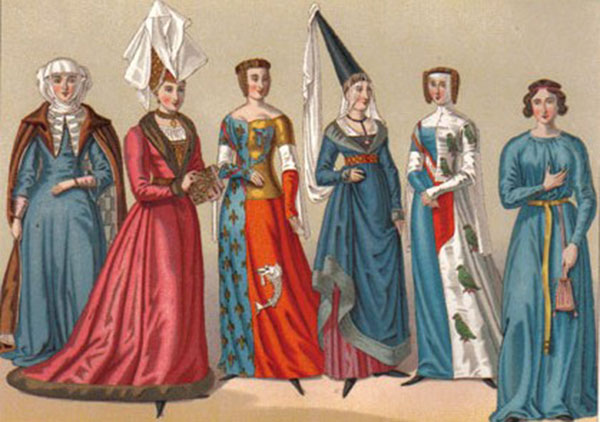Sumptuary laws established in the middle ages restricted clothing expenditures to maintain class structure.
English laws governing fashion and dress were first recorded in the thirteenth century and regulated the apparel of workmen who were often supplied with clothes as part of their wages. In an attempt to preserve class distnction and especially the divide between the upper classes and the lower and middle classes, the laws were expanded to include all levels of society.
Sumptuary Laws in Medieval England
These laws distinguished social categories, enforcing visible differences in social stations. Strict penalties accompanied violation of sumptuary laws. Lawbreakers might be fined, have their property confiscated, suffer the loss of their title or in some cases face execution.
Knights objected hotly to inferiors mimicking their clothes. Women were expected to dress according to the social standing of fathers and husbands. Wives and daughters of servants were limited in what they could spend on veils. A fine was exacted from knights wearing shoes or boots with spikes or points longer than two inches. Silks in gold and purple were to be worn only by royals.
Those found guilty of manufacturing finery for unprivileged persons were subjected to the added penalty of a cursing by the clergy.
Clothing of Kings and Nobles in the Middle Ages
The most noted luxury among kings was found in the profusion of fur trimming mantles, surcoats and robes. By the eleventh century, velvet caps were reserved for persons of rank. Full length cloaks, closed shoes beginning to point and purses suspended from belts, were typical.
At the height of extravagance, clothes in the thirteenth century were lavished with gold, silver, pearls or precious stones. Massive gold belts, breeches and long stockings in matching colors and materials were the style and shoes were now fully pointed. The surcoat was made in cloth of mixed colors in scarlet, blue or reddish brown and embroidered with a noble’s coat of arms when engaged in combat.
Nobles sometimes wore clothing so short and tight that they needed help from two people to dress and undress.
Medieval Women’s Clothing
By the thirteenth and fourteenth centuries women of station wore trailing opulently decorated and embroidered gowns with close-fitting bodices overlaid by tight jackets that fell just below the hips. Jackets were frequently trimmed with fur and rich ornamentation. Sleeves were long and tight and fastened by a row of buttons. Shoes were long and pointed.
In the late fourteenth century the external corset came into fashion. Although women’s gowns were fastened in front up to the throat in the early medieval period, by the latter end of the period necklaces encircled the now bared neckline. Dresses also became full around the hips using padded rolls.
The clothing of women in the lower ranks of society was simple and inexpensive. Made of wool and dyed in the cheaply produced colors of off-white, grey, brown or red, the dress was fastened by a belt either at the waist or hips. Thick woollen shawls extended from the shoulder to mid-calf and mittens were worn to keep warm.
Clothing of Medieval Knights
A knight’s clothing was meant to keep his armour from chafing his skin. The knight wore a linen under-shirt and under-pants. His legs were covered in woollen stockings. An additional quilted garment padded with linen was used as a cushion for the armour worn over top. A belted robe was worn over the body armour and emblazoned with the device of the knight to identify him in battle.
The idiom, ‘clothes make the man’ was never more true than in the middle ages when station was judged by apparel.








